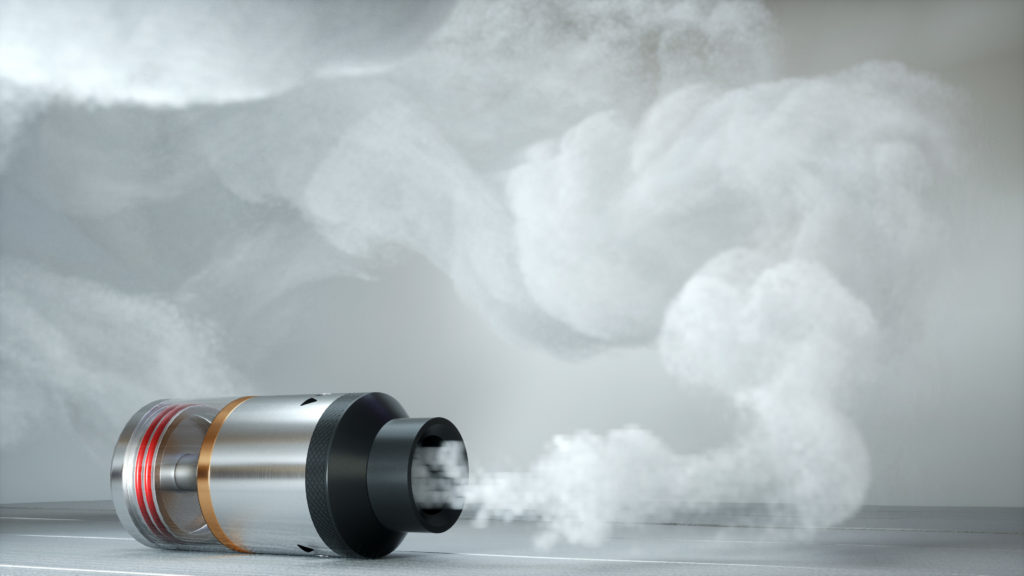Contributor: Dr. Elise Herman, KVH Pediatrics

As parents, we are vigilant about so many things- alcohol, drug use, Internet and technology issues. Here’s one more, and one that can fly under the parental radar. Vaping (using an electronic cigarette to inhale a vapor usually containing nicotine) is increasingly common among youth and has become very popular over the last 5 years.
Currently, more high school students use e-cigarettes then standard cigarettes. Although often touted as helping smokers quit, there is no evidence to support this, and when used by non-smokers, vaping may lead to nicotine addiction. In fact, youth who vape are more likely to use cigarettes or other tobacco products.
E-cigarette liquid typically includes nicotine (although not always), chemicals to vaporize the liquid (like propylene glycol) additives and flavoring. There are also other potentially harmful ingredients, including ultrafine particles that can be inhaled deep into the lungs, formaldehyde, heavy metals (lead, tin, nickel) and flavorants such as diacetyl, a chemical associated with serious lung disease.
Of course nicotine is the biggest concern with vaping because it is clearly a habit-forming drug that has harmful effects on the heart, lungs, kidneys and more. Immediate effects include increased blood pressure, heart rate and breathing. It is a stimulant so gives the user a surge of adrenaline as well as dopamine, a brain chemical that affects sensations of pleasure and pain. This increased dopamine makes people feel more contented—easy to see how this could become addictive! Additionally, there is a lot of research showing that nicotine causes cancer.
As e-cigarettes do not actually contain tobacco, use of these has been largely unregulated in the US, but this is changing. Some cities have banned their use wherever smoking is prohibited, and other regulations are in the works. States differ in term of who may buy e-cigarettes. In Washington state, the sale of these devices is prohibited to people age 18 and younger. Online sites, however, may not ask for proof of age. The use of vapor products is prohibited in schools, on playgrounds, on elevators, etc. in our state as well.
Youth frequently favor an e-cigarette is called “JUUL” (pronounced “jewel”). It is popular because it has sleek, small packaging that resembles a flash drive, all the better to easily carry and use. Easy to hide in a pocket, easy to use even in a school classroom. It is appealing due to its kid-friendly flavors such as mango and mint. JUUL is very addictive as it contains twice the concentration of nicotine of other ‘e-cigs’. Each JUUL pod contains the same amount of nicotine as an entire pack of cigarettes. Because of its ease of use, it is increasingly common on high school and college campuses, and users often share with peers, encouraging non-users to try it. Like JUUL, other e-cigarettes may look like household items- an asthma inhaler, a car key fob, a pen.
In terms of having a conversation with your child about vaping, it is good to approach the subject non-judgmentally and not to lecture. The topic might come up more naturally if it is response to seeing someone vaping or passing an e-cigarette shop. Acknowledge that you realize it is common, often due to the mistaken idea that it is risk free. Remind your child that his/her brain is still developing and that no tobacco product or nicotine is safe. There is a real risk for people who vape to also use tobacco products. If you do use tobacco yourself, being upfront about the health risks to you and the challenge of quitting is important. Emphasize that you do not want your child to face the same problem.
More information including a tip sheet for parents is available at the websites for the U.S Surgeon General and the American Academy of Pediatrics.
Managed by Kittitas Valley Healthcare, HealthNews does not provide medical advice. For medical advice, please see your healthcare provider.